PQ
a magazine from the

a magazine from the
Spring 2023 issue 47 news/food/innovations/wellness/marketing
feature story
Peanuts Shine in Global Cuisine Through Tradition and Innovation

New Peanut Genomics

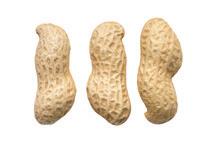


Database Accelerates
Research: Q&A With PeanutBase
We Grow Comfort with Millennials and Gen Z in 2023
National Peanut Board President and CEO
Bob Parker Announces Retirement
The National Peanut Board works on behalf of America’s peanut farmers and their families. Our mission is to improve the economic condition of USA peanut farmers and their families through compelling promotion and groundbreaking research.
National Peanut Board
2023 Officers and Members
Paul Rogers, Chairman
Greg Baltz, Vice Chairman
Casey Cox Kerr, Treasurer
Neal Baxley, Secretary
Alabama
Tom Corcoran
Thomas Adams, alternate
Arkansas
Greg Baltz
Allen Donner, alternate
Florida
William Carte
Nick L. Marshall, alternate
Georgia

Casey Cox Kerr
Wesley Webb, alternate
Mississippi
Lonnie Fortner
Alan D. Atkins, alternate
Missouri
Clay Deane
Russ Hoggard, alternate
North Carolina
Ray Garner Jr.
Julie Ward, alternate

Oklahoma
Mark DeLeon
Les Crall, alternate
South Carolina
Neal Baxley
Doug Jarrell, alternate
Texas
Jeff Roper
Mason Becker, alternate Virginia
Paul Rogers
West Drake, alternate
At-Large
Lucy Shackelford
Clifford Neece, alternate
As the 2023 chairman of the National Peanut Board (NPB), I appreciate the opportunity to represent America’s peanut farmers. I began my work with the Board as an alternate in 2012, then as a member in 2018. While a lot has changed in 11 years, our core mission has stayed the same: improve the economic condition of U.S. peanut farmers and their families through compelling promotion and groundbreaking research. I plan to continue that during my term.
This year’s compelling consumer campaign is something I am looking forward to. We’ve all felt the lasting impacts of coronavirus, and Gen Z and millennials have redefined what it means to take a step back and find comfort in the simple joys of life. Our campaign, “We Grow Comfort,” will show younger generations how peanuts can be comforting beyond just food. For our first activation, we sent out self-care kits with beauty products that use peanut as an ingredient. While my generation may not think about self-care the way our kids do, we can still find common ground through peanuts.

One of the biggest responsibilities the executive committee and I have is to find a successor for Bob Parker, who is retiring at the end of this year. The executive committee and I take this responsibility seriously and promise to provide transparency as we move through this process. He’s done tremendous work for U.S. peanut farmers in his 10 years leading NPB and his efforts in unifying all segments of the industry will have lasting impacts.
Finally, I’d like to thank my fellow peanut growers for trusting NPB to achieve our mission to benefit all of us.
Editor: Lindsay Stevens
SVP & Chief Marketing Officer: Ryan Lepicier

Lauren Highfill Williams
Markita Lewis, MS, RDN
Sydney Pollock
Sherry Coleman Collins, MS, RDN, LD
Valeri Lea
As for groundbreaking research, NPB has invested heavily in both allergy and production research. PeanutBase, which you’ll read more about in this issue, allows researchers to have a central database. PeanutBase saves researchers hours of looking through multiple databases to find certain markers for peanut breeding, which allows for progress to be made rapidly. Dr. John Cason from Texas A&M compared it to a snowball rolling down a hill with how as the research grows, advancements will be made exponentially quicker.
Paul Rogers ChairmanIn 2012, members of the National Peanut Board (NPB) chose me as their president and CEO. Working to represent the interests of America’s peanut farmers has been an honor and a highlight of my career. While this has been a life-changing experience, I recently announced my retirement at the end of 2023.
Though leaving behind a job and people that I love is difficult, retirement allows me to spend more time with my family and be closer to watch my grandchildren grow up.
As I close this chapter in my life, I feel good about where we are as an industry. We are as unified as I have seen it over my entire career. Though we have many industry organizations, our purpose and messaging is aligned, which effectively serves our stakeholders.

The last two years we have hit all-time per capita consumption levels of peanuts in the U.S. This has been a team effort by many hard-working people in our industry — grower and industry associations, shellers, manufacturers and allied segments. I am confident our efforts here at NPB played a part in this success.
In its early years, NPB members rightfully decided to address the peanut allergy issue. When I came on board, there was a team of knowledgable people in place dedicated to finding solutions. Unfortunately, peanut allergy is still a problem today, the single largest barrier to peanut consumption. However, we have made great progress. We now have early introduction of peanut to infants as a proven way to prevent peanut allergy. We are also supporting research that may one day provide a prevention for severe reaction and maybe an outright cure.
 BY BOB PARKER President & CEO
BY BOB PARKER President & CEO

Production research is one of my passions. How can we help farmers produce higher yields at lower costs, to become more competitive? Working closely with peanut scientists has also been a gratifying experience. The norm for yields has gone from 3,000-pound national averages around ten years ago to 4,000 pounds today. Our support of research in partnership with state and industry associations has played a part in this progress and will pay off for years to come.
The peanut industry has been good to me these past 47 years. I will miss the wonderful people, but I can close out my career with the hope I have made a difference for our peanut farmers and their families.
If you’ve ever attended a baseball game, the “Americana” of the peanut is obvious. Baseball and peanuts just go together. A PB&J sandwich is a classic brown bag American lunch and one of the top three ways consumers choose to enjoy their peanut butter1. Peanut shells litter the floors of our favorite steakhouses as diners patiently (or impatiently) snack on peanuts while waiting for their order to arrive at the table. A more exploratory eater can even get peanut butter on their burger now. And peanut butter use as an ingredient in adult beverages is up 46%1.
But peanuts did not originate in the U.S. They are not native to North America and play an even more significant role in global cuisines. While peanuts appear on 27% of foodservice menus overall, when you consider only ethnic restaurants, that number jumps to 31%2. The top dishes include satays and kabobs, pad thai, curry, side sauces and egg rolls or spring rolls.
As chefs continue to innovate beyond those basic top dishes, global cuisines are the center point of their innovation and peanuts continue to play a role. Like Café Beatrice in Cambridge, Massachusetts, which took a classic breakfast cookie in a new direction by adding peanut butter, oats, cocoa and dried cherries to pepitas, sunflower and flax seeds3 Peanut butter horchatas are also now appearing on menus3.
This is because peanuts have been a familiar part of diets across the globe.
Peanuts are sold roasted and salted on the side of the street, and over 27,555 tons of Japanese-style peanuts (peanuts coated in a sweet, crunchy shell) are produced in Mexico every year. Mole, from the Nahuatl word molli or mulli which means sauce, is an important part of Mexican cuisine. Spanish settlers started adding peanuts to mole as a thickener and flavor enhancer.
“We’ve recently used peanut butter in a Peruvian aji amarillo mole sauce,” said Chef Patrick McDonnell, owner of MKA culinary firm in Kansas City, Missouri “We don’t add the peanut butter to cut the spice, as much as a way to keep the green, fresh, slightly acidic experience you can achieve in a pepper mash. Peanut butter smooths the heat, so there’s not a spike, but the heat is carried throughout the flavor making for a much better eating experience.”
Peanuts originated in South America over 10,000 years ago and migrated northward to Mexico where they are ubiquitous in Mexican cuisine.
Peanuts can be found in mole sauces, snacks, street food, appetizers, desserts and drinks.
Restaurants serve roasted peanuts and potato chips as appetizers and fried peanuts are served with drinks at bars.
Peanuts were carried to Africa by Portuguese explorers. They play an important nutritional role in many parts of Africa since they have good fats and contain seven grams of protein.
Additionally, peanuts appear in West African stews, soups and sauces, as well as a Nigerian dry peanut-based spice rub called Suya. According to Technomic’s Emerging Eats report, Suya is among the top 50 menu trends to watch in the U.S. in 2023. Additionally, prominent foodservice magazine Flavor & The Menu included skewered meats on their Top 10 Trends for 2023 list, stating meat on a stick is part of nearly every cultural cuisine and Suya plays a big role in that trend to watch.
Peanuts are used to add crunch to bao buns and as filings inside Chinese pastries. According to Foodservice Director magazine, noodles are eaten as a symbol of a long, healthy life on Lunar New Year.
Flavor & The Menu names Thai mashups as another one of their Top 10 Trends to watch in 2023 as chefs mix Thai flavors and ingredients with American, Mexican or Korean formats. Chef Sam Yoo, formerly with Momofuku, opened an Asiancentric concept in New York, called Golden Diner. His Thai Cobb salad mixes the classic American salad with Southeast Asian flavors. It includes Thai basil, mint, bean sprouts and spiced peanuts, with the usual lettuce, bacon and medium soft-boiled egg.
“Peanuts are just a natural fit in global cuisine cooking in the U.S.,” says Chef Patrick McDonell. “Thai, Korean, Chinese, Indian, Portuguese, Spanish, South American, Mexican — they all use peanuts as an essential ingredient in their dishes.”
As U.S. demographics continue to shift toward residents with multicultural backgrounds, American classics may be redefined. But the peanut’s role in global cuisines will ensure it continues to have a strong presence on menus and in home pantries.
The National Peanut Board (NPB) is continuing our work with The18 — the most popular soccer website based in the U.S. according to ComScore — to engage players and fans of the sport through informative and interactive campaigns. Our goal is to reach consumers in fun, engaging ways to show them how peanuts can be part of any athlete’s or active person’s diet.
The 2022-23 calendar offers a unique opportunity to engage within the sport, with both the men’s and women’s World Cups playing out within 12 months. Fans across the U.S. and the world will be watching the sport, which allows us to take advantage of heightened interest to increase affinity and understanding of peanuts as a good source of protein and other nutrients for active people.

To date, we have worked with some of the biggest names in U.S. soccer to elevate peanuts — from Landon Donovan and Sydney Leroux to Jordan Morris and Weston McKennie. Since 2021, we have told stories that highlight peanuts as a part of the soccer lifestyle, which generated more than 34 million impressions and 9 million content engagements.
Over the past year, our campaign theme has been the “Official Sponsor of Teamwork” and we’ve done activations that engage players at all levels of the sport — from youth to college to the pros. The campaign celebrates how teams and players who work together can achieve great things. Peanut butter is highlighted as the ultimate teammate, blending well with almost any food ingredient to make a great snack.
During the men’s World Cup, we told a series of stories that connected at both the college and professional level of the sport to inspire young athletes with our teamworkfocused message. First, The18 collaborated with a pair of social media-active college athletes to showcase what life is like as a D1 college player through a behind-the-scenes video series. We then worked with U.S. player Weston McKennie (who we previously worked with during the 2021 Olympics) to produce a documentary exploring McKennie’s upbringing and how his support system helped him achieve success. This content garnered over 1.5 million impressions and 500,000 engagements.

This spring, we focused on highlighting the role of peanuts during the recovery process between games, with several educational articles and complementary social content. We also shared some of our favorite smoothie recipes that can help with recovery times. Looking forward to later in 2023, NPB and The18 have significant plans for the women’s tournament taking place in Australia and New Zealand in July and August.
See our previous activations with The18 by scanning the QR code below.
The National Peanut Board’s (NPB) work with the Culinary Institute of America (CIA) brings peanuts to the table by supporting the development of innovative menu items and addressing the challenges that foodservice operations face daily.
Every year, NPB is a corporate member of the CIA’s thought leadership initiatives to advance innovations in sustainability and food ethics, health and wellness, cultural diversity and inclusion.
NPB’s involvement with the CIA’s initiatives provides educational opportunities to corporate and executive chefs, foodservice directors, volume foodservice buyers, trade and consumer media and other industry opinion leaders.
The Worlds of Flavor Conference and Festival is held every fall in Napa, California. This highenergy event focuses on world cuisines, food cultures and flavor trends to showcase the old and new traditions of world cuisines that shape American palates and the food industry.
NPB has sponsored this event at various levels to showcase the role of peanuts in world cuisines and to connect with top chefs, food writers, food producers, food authorities and foodservice operators.
Most recently, NPB was the presenting sponsor for the 2022 event themed around Africa, and showcased recipes in their world marketplace, sponsored seminars and workshops, and featured breakfast items.

The Healthy Menus R&D Collaborative (HMC) is a solutionsoriented initiative for contract foodservice operations and chain restaurants to expand healthy food and beverage options available to consumers.
HMC has two in-person meetings held between the CIA campuses in Napa, California and Hyde Park, New York, with regular working-group calls throughout the year.
As a corporate member, NPB helps foodservice operators from different sectors understand how to use peanut products in their operations. This event also keeps NPB and operations up to date with consumer trends and insights, marketing strategies and innovative collaborations.
Menus of Change is a joint initiative of the CIA and Harvard T.H. Chan School of Public Health. Behind this initiative is the thought that changing menus is a powerful way to drive improvements in our health and planet and is the most important part of doing business in the restaurant and foodservice industry.
At the center of Menus of Change are the 24 principles of healthy, sustainable menus to help guide the future of the culinary profession and foodservice industry. NPB supports the plant-forward messaging of Menus of Change and connects with culinary leaders to create innovative solutions that bring the principles to life.
The CIA’s Global Plant-Forward Culinary Summit is the practical translation of the Menus of Change initiative and is inspired by the cuisine-focused Worlds of Flavor event.

This summit features cooking demos and culinary strategy based on the framework of the 24 principles of healthy, sustainable menus. NPB’s involvement with the summit embodies the principle and goal to “move legumes and nuts to the center of the plate.” We help foodservice operators find ways to shift menus towards promoting health and sustainability with peanut products and bring transformational menu items to the market.
At the heart of everything, NPB’s collaborations with the CIA are about building relationships. We can connect with leaders across foodservice and culinary industries and help them discover and expand upon the ways that peanuts can transform menus for amazing customer experiences. The insights gained from our involvement with these programs also help inform areas within our strategic planning. Keeping up with trends and concerns present within the food industry guides how we can most effectively promote peanut consumption across the country.
Peanuts are found everywhere, from being boiled at Southern gas stations to serving as Georgia’s official state crop. It’s safe to say this mighty legume has found its way into our hearts in the peanut belt. However, the modern peanut we think of today has had a long and winding history that has led us here.

The modern peanut originated in South America around 8,000 years ago, in a region today known as Northern Argentina and Southern Bolivia. According to researchers, there is overwhelming evidence that it comes from a rare cross between two wild species. Then, the hybrid underwent another rare event of genome duplication.
Dr. Soraya Leal-Bertioli is a senior research scientist at the University of Georgia. She and her husband, Dr. David Bertioli, run the Wild Peanut Lab.
“It was probably a plant with small seeds, but more vigorous, prolific and more prone to domestication,” Dr. Leal-Bertioli said. “Since it has been cultivated and selected by native peoples for higher number of seeds, larger pods, better flavor, resistance to pests and tolerance to stresses. Now we have a beautiful plant and tasty snack thanks to nature’s chance and human ingenuity.”
Native peoples spread peanuts from Argentina and Bolivia to other parts of South America and up into Mexico. As early as 1500 B.C., the Incans of Peru used peanuts as sacrificial offerings and entombed them with their mummies to aid in spirit life.
During Spanish exploration, peanuts were taken back to Spain and from there, they traveled around the world, including Africa. It’s believed that during the 1700s when Africans were brought to the U.S. as enslaved people, they carried some of their essential foods with them, which included the peanut1. Swedish botanist Carl Linnaeus was the first to describe peanuts in 1753, and botanically speaking, the peanut was very similar to the one we know today, however, as a crop it was very different.
“Because there was no breeding or cultivation technology, peanuts did not have the attention they do today,” Dr. LealBertioli said. “The seeds were planted and harvested by hand, it had low yield, and it had limited uses.”
The first known commercial peanut crop in the U.S. was grown in 1842 in Virginia’s Sussex County, close to the present-day town of Waverly 2 .
According to Dr. Leal-Bertioli, until the 1950s, peanuts had very little input and mechanization, but between the 1950s and mid-1980s there was more investment in technological advances, specifically chemical control of weeds, leaf spots, and seed- and soil-born disease. These developments led to a dramatic increase in yield.
“However, in the 1980s there was a huge setback in production with the emergence of the tomato-spotted-wilt virus, which severely reduced productivity by nearly 50%,” Dr. Leal-Bertioli said. “Luckily, resistance to this virus was found in a peanut type that had been obtained by an open market in Brazil years before. This plant started to be used by the main breeding programs and is today in the pedigree of most modern cultivars and is said to have saved the peanut industry from collapse in the ’90s.”
Since then, efforts into breeding have continued and investments have increased. Crop management and breeding now walk hand in hand to reduce input costs. Dr. Leal-Bertioli said that most peanut cultivars have some level of resistance to pests and diseases, such as root-knot nematode, insects and leaf spots.
The use of wild species, done on a small scale since the 1970s, is becoming more and more important in today’s world. Initially, it was more challenging since wild peanuts have 20 chromosomes, whereas cultivated species have 40 chromosomes. However, a pipeline has been created so that researchers can transfer resistances to pests and diseases, yield stability under different environments, drought tolerance, productivity, seed size, etc.
“Peanuts’ wild relatives give a clear edge in the race against pathogens and is important not only to sustain yields but to reduce inputs, helping with sustainability of the crop,” Dr. Leal-Bertioli said. “The U.S. National Peanut Germplasm Collection is the guardian of over 60% of all wild species that have ever been collected and have an enormous unexplored potential.”
In the first half of the 20th century, yields averaged around 900 pounds an acre. Today, average yields can exceed 4,000 pounds an acre. As research and breeding continue, our hopes of what this tiny peanut can offer also grow. As of now, the possibilities are countless.
Sources:
2022, https://blog.virginia.org/2020/ 10/virginia-peanuts-history/.
 By Lindsay Stevens
By Lindsay Stevens
PeanutBase is a community resource for the international peanut research and breeding community. Originally led by Ethy Cannon, this database allows for peanut-related research from around the world to reside in one central database. To learn more, NPB spoke with PeanutBase personnel Sudhansu Dash, who was involved with the site development, curation and content management, and has served as the lead of PeanutBase since 2020; Andrew Farmer, who worked on the generation of data and analysis for the International Peanut Genome Initiative (IPGI); and Steven Cannon, who played a major role in the assembly and analysis of the genome and is the lead or core developer on several software projects to make genomic data accessible.
A: PeanutBase was started in 2013 as the primary repository and portal for genetic and genomic data generated by IPGI. PeanutBase has matured with IPGI, and now provides tools that allow researchers to explore the genomes of the peanut and its wild relatives, along with related genetic resources integrated into the database. PeanutBase has evolved to accommodate and integrate major data types from researchers and breeders. There are tools for exploring and visualizing the ancestral diploid and tetraploid genomes, along with genetic maps, markers, traits and information about varieties and diversity.
A: PeanutBase is a repository for various data types from the research community and enables visualization and exploration of genetic and genomic data from IPGI and international research efforts. Site tools help users explore: the ancestral diploid and cultivated tetraploid genomes, along with genetic maps and markers from two genotyping chips; side-by-side comparison of genotype data; similarities between peanut genome regions and related genomes; browsing and mining genomic data; interactive geographic exploration of germplasm accessions; and phenotypic data visualization of the peanut mini core collection. Additional tools were integrated into PeanutBase to make genetic comparisons with other legume species. Molecular markers for important agronomic traits can be explored using the data and the tools. Researchers also deposit data here to fulfill journal publishing requirements.
The overarching objective is to make genomic data easily accessible and useful for incorporation into breeding programs, as well as to keep PeanutBase current with rapidly progressing research by integrating large amounts of new data.
A: The USDA legume group at Iowa State University and the comparative legume group at the National Center for Genome Research (NCGR) in Santa Fe, New Mexico provided bioinformatic research support in legume genomics even before the initial legume genomes were sequenced. Because of their expertise, three legume databases are now established in Iowa (SoyBase, the Legume Information System (LIS) and PeanutBase).
When the ancestral diploid genomes were sequenced, it was better to establish PeanutBase to leverage the expertise and experience of this collaborative group in Iowa and New Mexico. It was a small step to initiate another legume genomics database in Iowa with a well-established computational hardware and software support system rather than starting from scratch elsewhere. Dr. Cannon's group provided the hardware support for PeanutBase. This saved the infrastructure cost for the Peanut Research Foundation (TPRF), helped PeanutBase mature rapidly, leveraged information-rich legume species at LIS and SoyBase, and took advantage of the expertise on comparative legume genomics at NCGR. The updated computational infrastructure for PeanutBase and LIS are now housed at NCGR in New Mexico.
Q: How will PeanutBase impact future research?
A: As researchers, we have a community-facing portal providing a single source for submitting, downloading and exploring genomics and related data. This saves time by avoiding having to go to multiple internet resources for data. Wherever possible the genetic data (maps, markers and mapped traits) have been integrated with the genomic data, making it possible for breeders to leverage the resource in their breeding programs. PeanutBase can acquire and integrate new data types when the community generates and needs them, e.g., pan-genome data involving many peanut cultivars and related wild species. Overall, it makes genomic data useful for peanut breeding programs for improved cultivar development.
Q: How have growers contributed to the creation of PeanutBase?
A: The mandate for the creation of PeanutBase came from the IPGI, which is supported by growers and other industry members. That initial stimulus from the growers along with the financial support from TPRF has catapulted PeanutBase as a successful portal for researchers. The continued financial support from TPRF reflects support from the grower community.
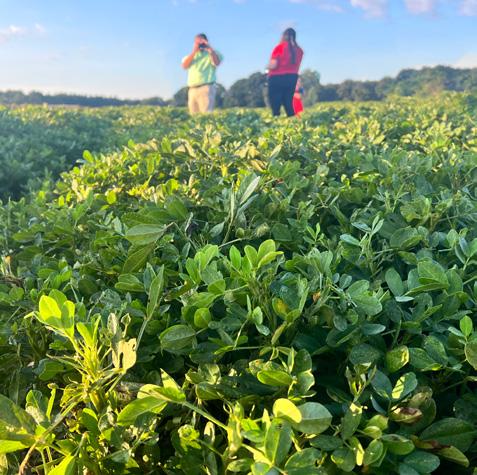
We also spoke to Dr. John Cason, Texas A&M AgriLife Research and Extension Center at Stephenville, to hear how researchers and peanut breeders, like himself, use PeanutBase.
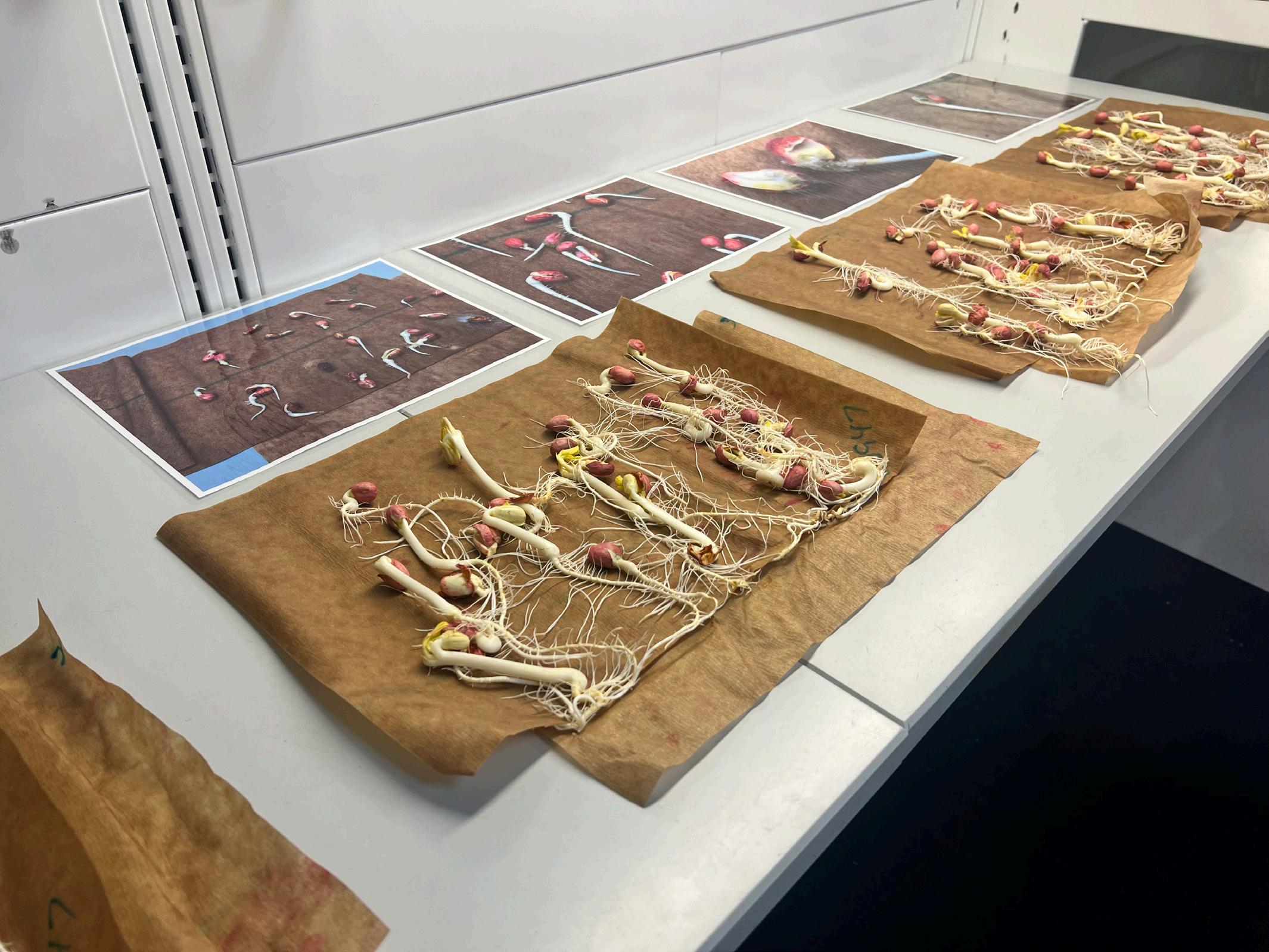
Q: How have you used PeanutBase?
A: As part of an ongoing project, we used PeanutBase as a search engine for genes and gene families associated with drought-tolerance genes we identified in a wild species. We subjected two wild species to a midseason drought and collected RNA for a gene expression analysis. Once we had genes that were associated with drought, we searched PeanutBase for gene matches from the reference genome Arachis ipaensis. Currently, we are starting to use some of the markers to make early-generation selections and eliminate materials before investing a lot of money in them.
Q: How does PeanutBase add value to our industry?
A: The information starting to be available on PeanutBase is staggering. From my perspective in an applied breeding program, we need to screen for traits the industry wants as early as possible. Those are becoming increasingly available on PeanutBase. Personally, there has been a lag in deciding exactly how to use the information, but we have started putting things in place that allows us to take advantage of it. Now there are markers associated with traits we are interested in, and we have developed materials related to the parents the markers were found in. This makes it easy to deploy those markers in the program. All of that to say, large amounts of constantly growing research that is easily available in PeanutBase is a game changer for the progress that can be made and the speed at which we can make it.

Peanut-based ready-to-use therapeutic food (RUTF) is already used to save the lives of severely malnourished children around the world. But RUTF is also impacting children in the West African country of Ghana who suffer from another life-altering condition: cleft palate.
A cleft palate or cleft lip is a gap in the mouth that didn’t close properly during pregnancy. Globally, one in every 500 to 750 births have a cleft condition, according to Operation Smile (OS). More than a cosmetic difference, cleft conditions can make eating difficult — which can lead to malnutrition or starvation — and bring challenges with speech and social development. Correcting a child’s cleft condition can have a profound impact on their well-being.
OS is a non-profit organization established in 1982 to provide cleft care in more than 30 countries with help from thousands of volunteers. OS has been working in Ghana since 2011, which is also one of the countries where Project Peanut Butter (PPB) operates.

George Birdsong of Birdsong Peanuts has been involved with OS since 1992 and with Dr. Mark Manary of PPB since 2006. The program was brought to fruition as a structured study and the results are pending publication.
“When I learned that OS was having trouble with kids not being healthy enough for their cleft lip/pallet operation, I suggested about five years ago to use the peanut-based RUTF product for six to eight weeks before the scheduled operation to get the kids healthy,” Birdsong said. “OS is now using RUTF where needed all over the world for this purpose.”
“Visiting the OS clinic in Accra, Ghana, was a truly moving experience,” Parker said. “Seeing firsthand how a peanut butter-based food can bring malnourished children to a place where they can endure surgery is gratifying and cements my belief in peanuts as a superfood.”
Learn more about the power of peanut based RUTF on The Peanut Podcast:
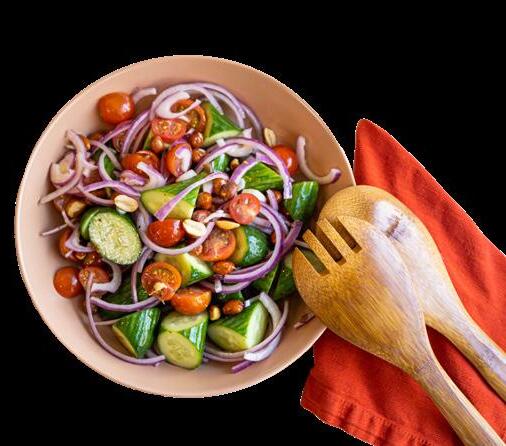 By Sherry Coleman Collins, MS, RDN, LD
By Sherry Coleman Collins, MS, RDN, LD

The flavor and versatility of peanuts are a familiar comfort, yet perfectly fit into today’s trends. As our team considered the emerging trends for this year, we looked at opportunities to provide recipes in categories that could show how peanuts shine! To that end, the National Peanut Board’s (NPB) dynamic duo of registered dietitians, Sherry Coleman Collins and Markita Lewis, got busy in the kitchen developing six new recipes for NPB’s website. We will be promoting these recipes throughout the year, and we hope you will try them in your kitchen.
Springtime calls for special, yet elevated dishes, and we have new recipes that will be perfect for spring holidays like Easter. The spring vegetable medley with peanuts is a celebration of spring’s first harvest, pairing crunchy and vibrant green vegetables with lightly salted red-skinned peanuts. As a vegan dish, it shows that plant-forward eating can be simple and delicious. Pair it with the delicate trout with peanut lemon-butter sauce for a flavorful and fresh meal. Dusting the fish with peanut flour gives it a warm nutty flavor that’s familiar yet surprising. Lastly, sweets are always on trend, so our recipe for peanut butter cupcakes with peanut butter frosting & Easter eggs was designed for Easter, but they are a perfect ending for any meal.
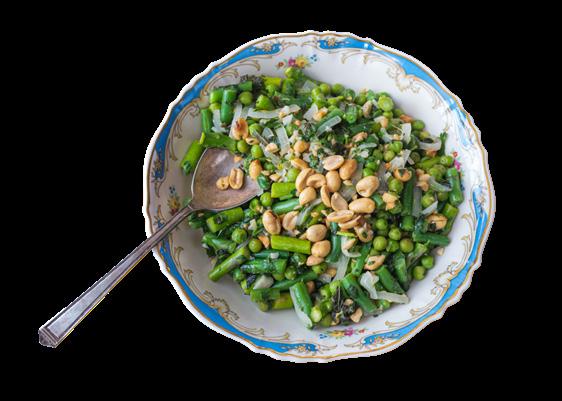
Hot summer days call for cool salads, and our new cucumber tomato salad with peanut vinaigrette is sure to satisfy you. The peanuts provide a welcome crunch and add plant-based protein to the dish. Pair it with the peanut empanadas with peanut sauce for a perfect meal. These vegetarian hand-held savory pies are a twist on the popular Spanish dish enjoyed all over South and Central America, the Caribbean and Mexico. Typically timeconsuming and fried, this recipe uses store-bought pie crust and is baked to make it a more approachable dish for anyone. To further show peanut’s versatility, they stand in for meat in our peanut-stuffed poblano peppers adding crunch and texture to the filling.
This new cadre of recipes offers a creative take on using peanuts, peanut butter, peanut flour and peanut oil. Representing trends like vegetarian and plant-forward eating, global flavors and traditional foods with a twist, these recipes are sure to help our team position peanuts as a top choice for chefs, foodservice and consumers.

Gen Z and millennials seek comfort in nearly every aspect of their lives. No matter how much the world returns to normal, Gen Z and millennials have redefined what it means to step back from the craziness and focus on moments of serenity.


Peanuts and peanut butter have always been there to provide comfort. Peanuts not only bring back fond memories, but they also help make the times we are in a little bit cozier. This year, the National Peanut Board (NPB) will show younger generations how peanuts can go from being a comfort food to helping the world be more comforting.
We will do this through activations that redefine what peanut butter and comfort means to them. We do not just grow peanuts, “We Grow Comfort.” NPB will fill 2023 with comfort and care by putting peanuts and peanut butter at the center.



Self-Care is the focus in our first activation. From face masks to dopamine dressing, millennials and Gen Z find comfort in their self-care rituals. These routines can include anything from nutritious eating patterns and beauty product benefits, to calming candles and soothing playlists. For these two generations, acts of selfcare are a way to provide comfort amid the stressors of daily life. NPB will show how peanut farmers can grow this comfort by sharing the lesser-known functional benefits of peanuts — including the use of peanut oil as a moisturizing hair oil or the nutrient benefits of peanut skins1 Comfort food becomes a comforting ritual that introduces the benefits peanuts one can add to their self-care routine.
A Common Comfort will be our second activation and will take place this summer. Throughout history, humans and animals have bonded with each other. Though we love to give them their own creature comforts, peanut butter is one human comfort food that we can safely share together. NPB plans to make the first snack that both dogs and owners can enjoy together featuring peanuts and peanut butter 2 — helping humans and their pets find a new way to bond.
Dine with Comfort is our third activation, which will take place this fall. Diners are a comforting home away from home, and America’s love for them runs deep — from funny sitcoms to famous paintings. We will tap into that nostalgia by adding peanuts and peanut butter to the menu and on your plate. Our chef-driven diner experience for media and influencers will bring the comfort of peanuts to a space known for being free of everyday stresses.

Brad West of Fremont, North Carolina is a farmer who often thinks about the future. With the V-C region switching to 100% high-oleic peanuts, West is excited about the future demand for peanuts and the potential to keep the next generation in farming. He farms with his mother, Audrey, and brother, Craig; and in addition to peanuts, the Wests grow tobacco, cotton, sweet potatoes, corn and soybeans. They also have turkey houses and a hog farm.
Farming has always been a part of West’s life. He graduated from North Carolina State Ag Institute in 1998, then returned home to make farming his full-time career and has farmed ever since. West currently serves as treasurer of the North Carolina Peanut Growers Association. He also serves on the State Farm Bureau Peanut Policy Review Committee and the North Carolina State Ag Institute’s Advisory Committee.
“It’s a career like nothing else,” West said. “It has a lot of struggles. It seems like we are constantly fighting for something, but it is a good life. What interests me the most is watching things grow and reaping the benefits of hard work with a little help from the good Lord.”
Recently, the V-C region switched to 100% high-oleic peanuts. These are higher in oleic acid, which means they are high in monosaturated fats or “good fats.” It is believed that monosaturated fats help lower bad cholesterol, raise good cholesterol and promote good cardiovascular health. High-oleic peanuts also have extended freshness and shelf life.
“I feel like the transition has allowed me to plant more peanuts,” West said. “We are living in a healthy world now and everyone is looking for healthier foods, so I feel like the demand is higher.”
West feels that going forward, there will be a higher demand for foods that are good for heart health. Scientific evidence suggests but does not prove that eating 1.5 ounces per day of most nuts, including peanuts, as part of a diet low in saturated fat and cholesterol may reduce the risk of heart disease. This positions all peanuts, including high-oleics, to help fill that demand in the future.
In addition to looking forward to this new demand for peanuts, West is excited to see how his operation will change over the years — in more than one way.
“I look forward to seeing where our farm will be in the future,” West said. “I have two nephews who are going to farm. One is working with us now, and one is in college with intentions of coming back. I have two kids; however, they are not interested in coming back. They have an idea of what they want to do, and I think that is great. This life is not for everyone. I am interested to see where we are in 20 years. With the technology coming and the population growing, we have our work cut out for us, but I look forward to seeing it happen.”
The Food Allergy & Anaphylaxis Connection Team (FAACT) has proudly partnered with the National Peanut Board (NPB) for the past 10 years. NPB’s commitment to the food allergy community and our goals of education, awareness and research is commendable.
During FAACT’s inaugural Teen Retreat weekend, a parent asked me in front of the attendees, “Why is FAACT working with NPB? They promote peanut consumption and sales, and many families that FAACT supports are managing peanut allergy.” I shared with them that NPB has supported food allergy education, awareness and research for many years and donated millions of dollars toward education and research. They want to be part of the solution, not the problem. And we want them working with FAACT on behalf of the food allergy community. The parent replied, “That makes total sense. Thanks for explaining the partnership to us. I’m so glad they want to support our families.” I delivered that message to parents many times in the first few years of our partnership with NPB. Then the food allergy community saw first-hand how committed NPB was to supporting our families, raising awareness and supporting research to end life-threatening allergic reactions to peanuts and other foods.
With support from NPB, FAACT launched our Food Allergy Curricula Program for Schools in May 2015. We are the only U.S.based organization that offers a food allergy curricula program. This curriculum consists of three age-appropriate programs — grades K-3, grades 4-8 and high school — with free teacher-designed presentations, lesson plans and activities that can be used to introduce your students to common food allergens and safety protocols while encouraging empathy for classmates with a food allergy. We thank NPB for their commitment to education and raising awareness about food allergies and anaphylaxis.

NPB’s support makes numerous other educational programs possible, including Camp TAG (The Allergy Gang) for youth and teens, the Food Industry & Research Summit for professionals, a leadership summit for FAACT-recognized support group leaders, and our Teen Retreat. All that plus FAACT’s ongoing, mission-based initiatives for education, civil rights advocacy, behavioral health, and diversity, equity and inclusion. FAACT has partnered with NPB and the American College of Allergy, Asthma, and Immunology on awareness campaigns for accurately diagnosing and managing a food allergy and advancing early introduction to prevent peanut allergies.
Since NPB’s inception, America's peanut farmers have contributed over $36 million to food allergy research, education and outreach. FAACT could not be prouder of our partnership with NPB and the support they have given the food allergy community. Thank you to NPB on behalf of our entire community. We look forward to working together for years to come.
State-certified peanut producer organizations extended their grower dollars by partnering with the National Peanut Board (NPB) in 2022 on co-promotions to drive excitement about peanuts. Seven states leveraged the program this year to promote the great taste, nutrition, sustainability and affordability of America’s beloved nut.

PREPARATION
Place honey, butter, salt and pepper flakes into a microwavable-safe bowl and microwave for 1-2 minutes or until boiling. Add the raw shelled peanuts to the bowl and stir, covering thoroughly with the honey butter salted mixture. Once mixed, spread hot honey peanuts onto a baking sheet lined with foil.
Preheat your air fryer to 350 degrees. Once heated, spray the bottom of the air fryer with spray oil (canola or vegetable). Toss peanut mixture into the air fryer basket, making sure to spread the mixture evenly across the bottom of the basket.
Cook for 8-10 minutes, stirring every 3 minutes to ensure the peanuts do not burn. Adjust timing as needed. Depending on the size of your air fryer, peanuts may need to be cooked in batches.
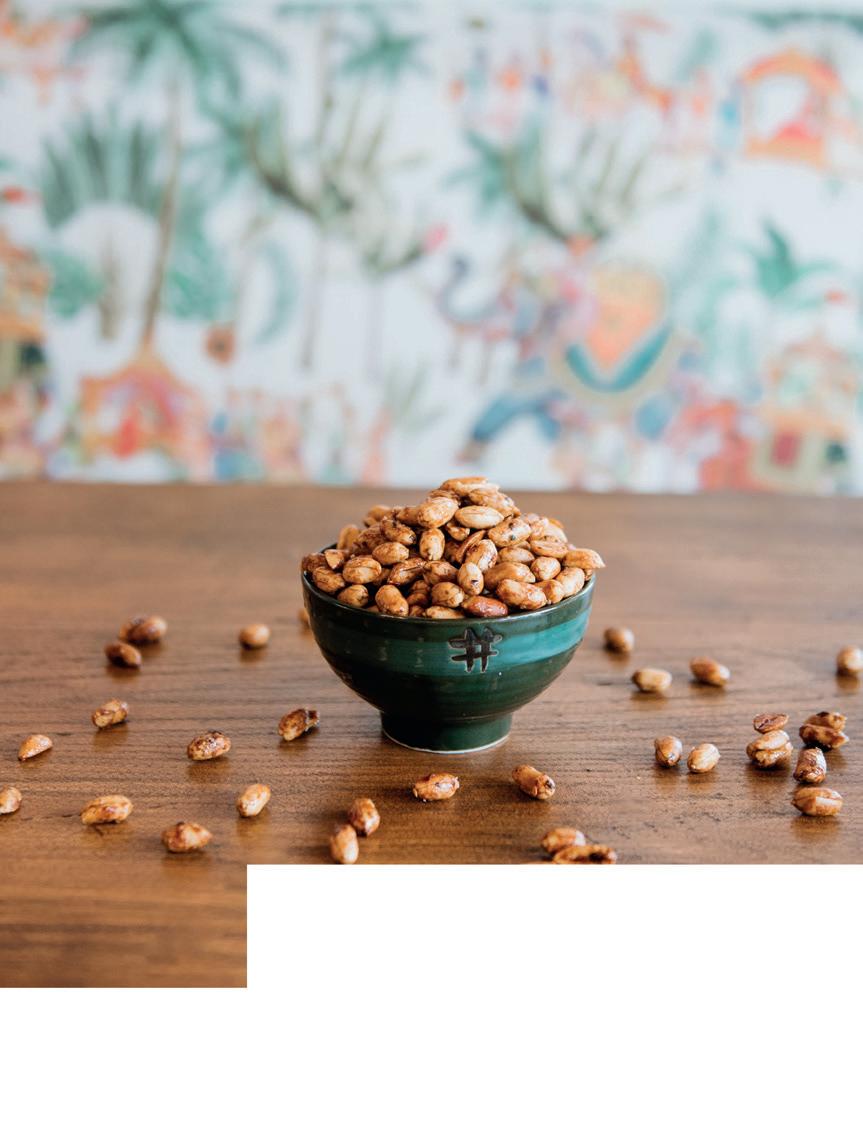
Once done, allow peanuts to cool completely on a baking sheet. Store peanuts in an airtight container. Should last 1 week.
Enjoy!

To learn more about this powerful plant-based protein source, visit our website aboutpeanuts.com
To learn more about peanuts visit our website
Recipe by Chef Sera Cuni with Root Cellar in Pittsboro, NC aboutpeanuts.com
North Carolina Peanut Growers Association, South Carolina Peanut Board, and the Virginia Peanut Growers Association used their co-promotion funds to create two full-page advertisements in magazines owned by EatingWell. First was an air fryer roasted peanut recipe, published in Air Fryer Recipes. The second promoted the benefits of eating peanuts daily and was published in Eating for Weight Loss.
Alabama Peanut Producers Association used its funds for consumer engagement. They updated their snack peanut bags, which are distributed to more than 100,000 people, and had new art printed for their pop-up tent for outdoor events.



Georgia Peanut Commission brought social media influencers to South Georgia for a tour of peanut harvest. The group visited a buying point, sheller, RUTF maker and farm; and learned about peanut research and shared the experience with their followers.

Oklahoma Peanut Commission passed out roasted peanut samples and “Perfectly Powerful Peanut” themed swag to the estimated 2500+ visitors that stopped by their booth at the Farm-to-Table Festival at the Oklahoma History Center. They also hosted their annual Oklahoma State Fair Cooking with Peanuts Contest on September 22. The winning recipe was Jennifer Howeth’s Peanut Butter and Raspberry Crunch.
Mississippi Peanut Growers Association sponsored the Mississippi State University vs University of Tennessee baseball game that took place on May 21, 2022. The “Perfectly Powerful Peanut” logo was used throughout the game, including on the Jumbotron during the game and on the literature and peanut bags that were passed out. Additionally, peanut mascot Buddy McNutty threw out the first pitch to start the game, and peanut trivia was shown throughout. A radio interview was also conducted to promote MPGA and NPB activities.

National Peanut Board (NPB) President and CEO Bob Parker has informed the Board that after 10 years he plans to retire at the end of 2023.
“The last 10 years as President and CEO of NPB have been the highlight of my career that will span 47 crops,” Parker said. “I will always be grateful to the team at NPB for their tireless efforts to carry out our mission and to the many Board members who supported and trusted me to represent them.”
A search committee for NPB has begun the process to ensure a smooth transition. The Board’s executive committee has hired executive search firm Vetted Solutions to lead the search for a CEO successor. Those interested in applying can send their resume to npbceosearch@vettedsolutions.com.
“I speak for the entire Board when I say we are thankful for Bob and his many years of service to the industry. His vast experience and knowledge have had a tremendous impact on NPB and the entire industry. His efforts in unifying all segments of the industry will have lasting impacts,” said NPB Chairman Paul Rogers. “He will be hard to replace, but he’s leaving a great legacy. Bob is making himself available during the search and transition process, and I’m confident that with the knowledge and support of our board of directors and search committee, we will find the right candidate.”
Parker joined NPB as president and CEO in 2012, bringing his experience and expertise in the peanut industry to help further develop the Board’s mission to improve the economic condition of U.S. peanut farmers through compelling promotion and groundbreaking research.
“Peanuts have been a part of my life since selling boiled peanuts on the streets of Bainbridge, Georgia, at age six,” Parker said. “I grew up in the business and peanuts not only helped provide for my family, they became a part of my identity.”
During Parker’s tenure, NPB has celebrated a number of industry achievements, including per capita peanut consumption reaching an all-time high of 7.9 pounds in 2021. Significant progress has been made in the treatment and prevention of peanut allergies, including federal guidelines for the introduction of peanut to infants to help prevent peanut allergy. Another milestone resulting from early NPB support was the introduction of an oral treatment, Palforzia. Additionally, during Parker’s tenure, NPB played a major role in advances in agronomic research, particularly in the area of genetic tools for marker-assisted breeding that will provide new varieties of peanuts to farmers with beneficial traits, such as leaf-spot resistance.
Before coming to NPB, Parker worked for Golden Peanut Company for 25 years in various roles. Parker’s experience began in Climax, Georgia, where he managed a family-owned farm service and supply business and a farm. He sold that company to Golden Peanut Company and moved through the company over the years.
Parker has been heavily involved in the peanut industry for decades and has served as chairman of the American Peanut Council, American Peanut Shellers Association, the Peanut Institute and the Peanut Administrative Committee. He has served on the Boards of the Peanut Foundation and Peanut Standards Board.


New National Peanut Board (NPB) members and alternates were appointed by Secretary of Agriculture Tom Vilsack to serve three-year terms, from Jan. 1, 2023 to Dec. 31, 2025, with the exceptions of the At-Large appointees whose terms began immediately and end Dec. 31, 2024. Greg Baltz and Allen Donner were reappointed as Arkansas member and alternate, respectively; and Clay Deane and Russ Hoggard were reappointed as Missouri member and alternate, respectively.
To learn more about our Board members and alternates, scan the QR code below.

DeLeon has farmed for 28 years and has grown peanuts since 2002. DeLeon is currently the chairman of the North Fork Red River Conservation District Board and also serves on the Oklahoma Comprehensive Water Plan Committee. Additionally, DeLeon has served in multiple capacities on the Elk City Summer Youth and Recreation board for 15 years and is an active member of the Sayre Church of Christ.
“I am thankful for the progress NPB has made in addressing peanut allergies and hope to play a part in further advancements to help the peanut industry to become even more profitable in the future.”
Les Crall has been peanut farming for most of his life. He previously served as NPB’s Oklahoma member, as well as our 2022 chairman. He currently serves as chairman of the Oklahoma Peanut Commission and serves on the Peanut Standards Board. Crall has been SWOSU faculty for 29 years and served as associate dean of the Everett Dobson School of Business & Technology. In 2018, he received the SWOSU Alumni Association Emeritus Award and was inducted into the Oklahoma Higher Education Hall of Fame in 2022.
“I’m excited to serve as an alternate for Oklahoma after serving as NPB chairman last year. I am looking forward to continuing to promote production research as well as allergy research.”
Previously, Shackelford served as the At-Large alternate for the Board. Shackelford and her husband, John, are the owners of Shackelford Farms, which produces runner peanuts, cotton, soybeans and occasionally rice. After earning a Bachelor of Arts from Millsaps College and Juris Doctorate from the University of Mississippi, Shackelford practiced law in Jackson, Mississippi. After marriage and her three children were settled in school, Shackelford became a district manager for clothing companies Carlisle and Worth NY.
“I have enjoyed meeting my fellow Board members, alternates and the staff over this past year. The marketing work the Board is doing is fascinating and I look forward to sharing a different perspective.”
Neece has farmed for 30 years and grows Valencia peanuts, corn, silage, wheat silage and hay grazer. He also raises beef cattle. Neece graduated from Portales High School in 1992 and is on the Arch Volunteer Fire Department, where he serves as assistant chief. He also runs a self-storage business in Portales.

“I’m hoping to learn about the whole industry, from breeding programs to marketing. I look forward to working to continue keeping the peanut industry vital.”

Whether hosting delegations of foreign buyers in the U.S. or organizing industry visits to established and emerging export markets, trade missions provide an opportunity to exchange knowledge and strengthen relationships with key customers from around the world. The easing of travel restrictions and increasing levels of Zoom fatigue led the American Peanut Council (APC) to resume in-person trade missions in 2022. These missions included the industry’s first official visit to South Korea, a harvest tour in Texas for key customers from Mexico, and a trip to Georgia for the Japanese trade.
A delegation from the U.S. traveled to South Korea to exhibit at the 2022 Seoul Food and Hotel trade show in June. Held annually, it is the largest food and beverage show in the country and brings together buyers and sellers from across Asia. The Texas Peanut Producers Board funded the exhibit with a grant from the Texas Department of Agriculture. Throughout the five-day show, trade leads were collected from over 20 importers, distributors and manufacturers interested in sourcing U.S. peanuts. The trip also included meetings with the Korean Peanut Import Association, which oversees raw peanut purchases, and with the Korean distributor of Skippy. In 2022, U.S. exports to this market increased 72% by volume and 33% by value to reach 5,197 MT and $14 million.

In mid-October, APC organized a visit near Lubbock, Texas for more than 20 U.S. exporters and 27 Mexican key importers, distributors and snack manufacturers. During the three-day trip, attendees visited fields, toured shelling plants and learned key aspects of peanut production. They also enjoyed presentations from the National Oceanic and Atmospheric Administration, the Peanut Institute, Kantar World Panel and JLA International. Since APC last hosted a delegation from Mexico, the country has grown to become the top international market for U.S. peanuts, with shipments totaling 149,119 MT valued at $212 million in 2022.
From Nov. 7-10, APC hosted a group of Japanese key customers near Americus, Georgia. The tour was supported by the American Peanut Shellers Association, National Peanut Board, Georgia Peanut Commission and National Peanut Buying Points Association. The 17 Japanese attendees and 25 U.S. industry members visited a peanut farm, toured a buying point and shelling plant, visited the JLA laboratory in Albany, and toured several grocery stores to see peanut products available to American consumers. There was also a session featuring presentations about sustainability, the status of the 2022 crop, peanut nutrition and marketing, and U.S. consumer trends and new products. Exports to Japan last year grew 22% by volume and 11% by value to reach 20,164 MT valued at $35 million.
Fiscal Year 23 (November 1, 2022—October 31, 2023)


